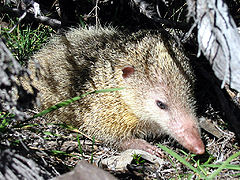Afrosoricida
| Afrosoricida[1]
| ||||||||||||
|---|---|---|---|---|---|---|---|---|---|---|---|---|
 Tenrec ecaudatus
| ||||||||||||
| Scientific classification | ||||||||||||
| ||||||||||||
The order Afrosoricida (a Latin-Greek compound name which means "looking like African shrews") contains the golden moles of southern Africa and the tenrecs of Madagascar and Africa, two families of small mammals that have traditionally been considered to be a part of the order Insectivora.
Some biologists use Tenrecomorpha as the name for the tenrec-golden mole clade, but Gary Bronner and Paulina Jenkins argue that Afrosoricida is more appropriate, despite their misgivings about the similarity between the name "Afrosoricida" and the unrelated shrew subgenus Afrosorex.[1]
Traditionally, these two families were grouped with the hedgehogs, shrews and moles in the Lipotyphla. However, there have always been minority opinions suggesting that Tenrecomorpha, or at least the golden moles, are not true lipotyphlans. These opinions are now supported by many genetic studies indicating an association between Tenrecomorpha and various other African mammals in the superorder Afrotheria; however there is no strong morphological evidence to link the Afrosoricida together with other Afrotherians. The Afrosoricida are sometimes considered part of the Afroinsectiphilia, a clade within Afrotheria.
As a rule, tenrecs tend to be small animals varying from 4 cm to 39 cm in length. There is no pronounced body type since they have evolved to take over the insect-eating niche in Madagascar. However, based on the niche occupied, they look like shrews, hedgehogs or otters. Their coat can vary from smooth to spiny and the coloration of the fur is generally dirt brown. Most species are also nocturnal and have poor eyesight. However, their whiskers are rather sensitive and they can detect very minute vibrations in the ground to locate their prey.
- INFRACLASS EUTHERIA: placental mammals
- Superorder Afrotheria
- Clade Afroinsectiphilia
- Order Afrosoricida
- Suborder Tenrecomorpha
- Family Tenrecidae: tenrecs and otter shrews; 30 species in 10 genera
- Suborder Chrysochloridea
- Family Chrysochloridae: golden moles; about 21 species in 9 genera
- Suborder Tenrecomorpha
- Order Macroscelidea: elephant shrews
- Order Tubulidentata: Aardvark
- Order Afrosoricida
- Clade Paenungulata
- Order Hyracoidea: hyraxes
- Order Proboscidea: elephants
- Order Sirenia: manatees and dugongs
- Clade Afroinsectiphilia
- (Other superorders, not listed here)
- Superorder Afrotheria
ReferencesISBN links support NWE through referral fees
See also
- Pseudoungulata
- List of mammals of Madagascar
| Mammals |
|---|
| Monotremata (platypus, echidnas) |
|
Marsupialia: | Paucituberculata (shrew opossums) | Didelphimorphia (opossums) | Microbiotheria | Notoryctemorphia (marsupial moles) | Dasyuromorphia (quolls and dunnarts) | Peramelemorphia (bilbies, bandicoots) | Diprotodontia (kangaroos and relatives) |
|
Placentalia: Cingulata (armadillos) | Pilosa (anteaters, sloths) | Afrosoricida (tenrecs, golden moles) | Macroscelidea (elephant shrews) | Tubulidentata (aardvark) | Hyracoidea (hyraxes) | Proboscidea (elephants) | Sirenia (dugongs, manatees) | Soricomorpha (shrews, moles) | Erinaceomorpha (hedgehogs and relatives) Chiroptera (bats) | Pholidota (pangolins)| Carnivora | Perissodactyla (odd-toed ungulates) | Artiodactyla (even-toed ungulates) | Cetacea (whales, dolphins) | Rodentia (rodents) | Lagomorpha (rabbits and relatives) | Scandentia (treeshrews) | Dermoptera (colugos) | Primates | |
Credits
New World Encyclopedia writers and editors rewrote and completed the Wikipedia article in accordance with New World Encyclopedia standards. This article abides by terms of the Creative Commons CC-by-sa 3.0 License (CC-by-sa), which may be used and disseminated with proper attribution. Credit is due under the terms of this license that can reference both the New World Encyclopedia contributors and the selfless volunteer contributors of the Wikimedia Foundation. To cite this article click here for a list of acceptable citing formats.The history of earlier contributions by wikipedians is accessible to researchers here:
The history of this article since it was imported to New World Encyclopedia:
Note: Some restrictions may apply to use of individual images which are separately licensed.